Preface
The cover of this book depicts a national icon. The monument of freedom in central Riga, erected 1935, with the sculpture on the top of a beautiful girl nicknamed Milda, has served as an encouragement to the Latvian people and the place around as a gathering point in war and peace, during occupation and in freedom. After the independence from the Soviet Union in 1991 and before joining the European Union in 2004, the monument was wrapped in solid scaffolding for a long period and financial means were collected for its reconstruction. Was the sturdy scaffolding a metaphor for the commitment to social change? When Milda was overlooking Riga again, it was a new society, where much had been changed, and much as a result of compromises between shifting values. And what about living conditions and health during this process?
When this book sees daylight, it is the offspring of a pregnancy lasting more than a decade. It has been written by two physicians, one from Riga, the other one from Oslo, looking on Latvia from their respective perspectives.
When Guntis Kilkuts lived in the middle of the political earthquakes shattering his country in the years around 1990, it was quite clear to him that major changes were ahead. In Oslo, on the other side of the rusting iron curtain, pictures from the closed, but yet so near Baltic States flamed over the television screens, indicating the same – here was an imminent opening, most likely towards the west.
Guntis Kilkuts (born 1961) a medical doctor trained at the Riga Medical Institute (now Riga Stradins University), graduated 1985 and had served his mandatory internship years in the Soviet system health services in cities and in the countryside. What would happen now to the health conditions, to the provision of health services, and to the whole public health system? This led him into an active role as a participant in the work to transform the health services, especially in order to set up a general practice model. The discipline of family medicine in the Western sense was not yet existent in Latvia.
Øivind Larsen from Oslo (born 1938); a professor of medical history with a public health background, 1993–1999 Academic Head of the Institute of General Practice and Community Medicine at the University of Oslo, felt the same excitement about the situation. In addition, attempts to establish contacts with professional counterparts in medical history in the large medical museum in Riga during the Soviet period had been fruitless. Perhaps the time had come to explore the Baltics personally? Following a first visit in 1993, the trips to Latvia became more than frequent and not only to enjoy the hospitality and collaboration with the medical museum; where thanks are due to the late Professor Karlis Arons, Associate Professor Juris Salaks and their colleagues.
The other reason was an instant understanding as the wheels of the aircraft bumped down the concrete plate covered runway of Riga airport in 1993: In case a swift modernization of Latvia to western standards would take place, a condensed history of welfare development would follow suit – and this would turn the country into a social laboratory and showpiece, ideal for student training.
And the development would probably also cover other fields of life as the way to the West opened up: The flashy world of the new western TV-channels pouring in, the at first albeit occasional tourists with their pockets bulging from the same Latvian rouble notes as were hard to earn by most Latvians, the tempting but long unreachable western merchandise appearing in the shops, and the luxury cars with black stained windows which began to rush through Riga, making the crossing of a street a risky venture. In comparison with the preliminary onset of decay in health and health services, there was a tricky conflict between the values of life ahead.
Latvia could also be expected to become an arena for external advice: Ranging from politics to market and cultural values from abroad, all competing with local traditions. What would the outcome be?
Choice in itself also seemed to be a new challenge. Though the regulated Soviet society offered options, they were not so plentiful, and the choices were often taken by others. Perhaps most importantly: In the new market economy, choices might have wider personal implications. For example, should one spend money paying for health services that were previously available for free, or should the surplus be spent for achieving other goals? Even in this field, rapid changes were likely to take place, another interesting topic for visiting students.
So, from 1995 until 2001, groups of four to six medical students from the University of Oslo were deployed to Riga two times a year to take part in a four week public health training and information programme. This was developed in collaboration with Guntis Kilkuts, and set up, administrated, and led by him* See the special issue “Baltic health” ,# 4/2004 of the Norwegian medical journal Michael. The relevant articles have been listed in the reference chapter of this book..
So, over the years, Norwegian students participated in the Riga placement scheme. Each group had to write a report, and both the supervision and the subsequent reading of the different reports gave a very good insight into the processes of change taking place.
A number of the Norwegian students visiting Latvia collaborated with corresponding student groups travelling to the United States of America in teams of four. In the US, students collected material for reports to be written on the same topics as the corresponding Latvia groups, drawing on experiences from their four week internship in hospital and primary health care practice in the Mid West area in and around La Crosse, Wisconsin. Back in Oslo the medical experiences from the two worlds were put together, compared and discussed.
The subsequent theses containing comparisons between Latvia, USA, and Norway, proved to be interesting and useful for both the students and their supervisors, and the students returning from the US contributed in an important way to shed light on the development in Latvia. The reports described encounters between medical and cultural worlds and sparked reflections as to what is important in life.
In addition, a special idea soon came up: Øivind Larsen brought his cameras to Latvia on every visit. It became an obvious thought to try to also monitor the development through the lens. However, when dealing with medical and social issues and photography, there are clear tacit, ethical restrictions as to how and which pictures can be used – if one wants to avoid insulting people or intruding into their private sphere. Therefore, photographs which perhaps for some topics might have underpinned our text deliberately are not found here.
It has been our intention to use photographs as an independent supplement to the text, and let them tell their own story about everyday conditions which soon will be forgotten. The photographs are meant to make this book a different one, especially because the interpretation of pictures has its own methodological problems and practical bearings. Our thanks are due to all those who did not object when the camera came up. Thanks go to Mr. João Rodrigues of the Hofmann Fotokopi shop in Oslo, who spent hours together with Øivind Larsen preparing photographic enlargements for the book.
Thanks also go to the large number of colleagues and informants we met whilst we were both engaged in the multinational Task Force for Combating Communicable Diseases in the Baltic Sea Region 2000–2004* See Hønneland & al. 2004., and to those around 1000 Latvian informants who participated in our empirical surveys on use of primary health care services and health risk perception* See Kilkuts & al. I and II 2005..
Changes going on in Latvia in many fields around the 1990s have been extensively studied, also regarding health. Our intention is not to compete with or reproduce studies performed by others, but rather to present the case of Latvia as it has emerged through our continuous observation, perusing the inside-out perspective of a local medical professional and the outside-in perspective of a visitor from the same profession. In some fields, literature and documentation are scarce, in other fields more abundant, yet often telling the same story. Therefore, in our bibliography, literature has been selected which is supposed to be useful for further studies by our readers.
The help from many people should have been acknowledged here, including all the young medical students who gave us ideas and corrections, either intentionally or not.
Last but not least: Valuable comments on our manuscript by Professor Magne Nylenna and Ambassador Harald Siem are duly acknowledged, and so is also financial support for the project provided by the Institute of General Practice and Community Medicine in Oslo, The Norwegian Medical Society and by The Task Force for Combating Communicable Diseases in the Baltic Sea Region.
Thanks also go to our British colleague Dr. Meetali Kakad, who has polished our English language and thoroughly searched the text for logical inconsistencies and other weaknesses. In addition, we are indebted to Mrs. Turid Jensen, who has used her computer skills to design the diagrams and to edit text and illustrations into data files ready for printing.
Oslo/Riga, August 2005
The authors
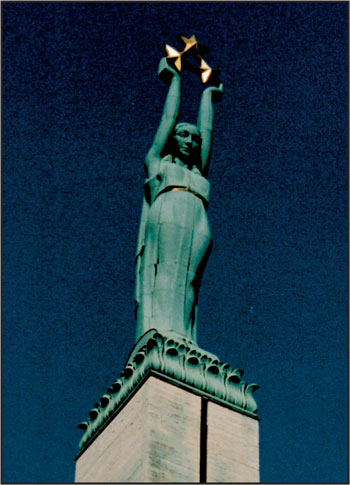
Three stars on the top of the freedom monument in Riga, symbolizing three parts of Latvia: Kurzeme, Vidzeme, and Latgale (1993).
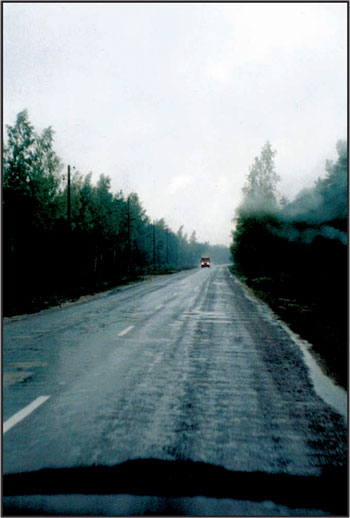
Road near Tukums 1999.
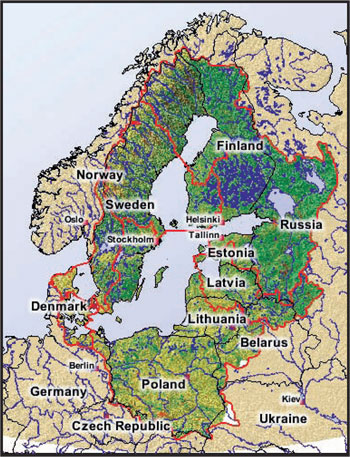
Latria in the Baltic Sea basin
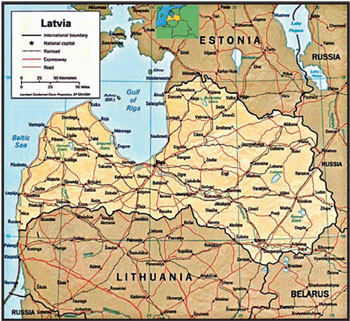
Latria in the Baltic Sea basin
Latvia – some facts* Updated statistics on Latvia may be found in different sources. The statistical figures and facts presented in this book were mostly taken out of the current official national statistics, see the reference list. However, on the internet information also may be found on the websitewww.cia.gov/cia/publications/factbook/geos/lg.html (CIA - The World Factbook – Latvia). (The facts presented on this page are from this source, updated June 2, 2005.)In addition, information about health and health care should be sought from the website www.observatory.dk. Here the European Observatory on Health Care Systems, WHO Regional Office for Europe presents its series Health care systems in transition, giving in depth information and opportunity for further international comparisons of the issues discussed in this book.. Comparable data for just Latvia from and before the beginning of the transition period are not so easily available, as Latvia at that time in the statistics was part of the Soviet Union.:
Location: At the Baltic Sea, between Estonia and Lithuania. Borders also to Belarus and Russia.
Area: 64 589 sq km, including 1 000 sq km water. Mostly low plain, some hills in the east, highest point 312 m.
Population: 2 290 237 (July 2005, estimated)
Age structure: |
0–14 years: |
14,4 % (male 169,284/female 161,648) |
15–64 years: |
69,4 % (male 770,839/female 819,309) |
|
65 years and over: |
16,1 % (male 120,306/female 248,851) (2005 est.) |
Median age: total: 39,12 years, male: 35,95 years, female 42,15 years (2005.)
Population growth rate: – 0,69 % (2005 est.)
Labour force: 1,17 million (2004 est.)
Labour force by occupation: agriculture 15 %, industry 25 %, services 60 % (2000 est.)
Gross domestic product (GDP) – composition by sector: agriculture 4,4 %, industry 24,8 %, services 70,8 % (2004 est.)
Unemployment rate: 8,8 % (2004 est.)
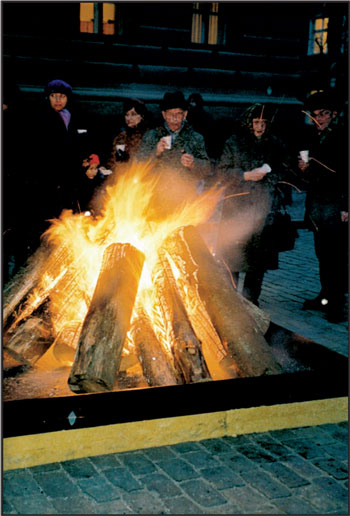
Bonfire in Old Riga 2001.
